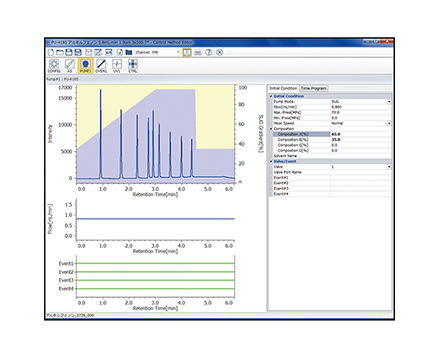Analysis of Fatty Acids in Rice Bran Oil, Coconut Oil and Margarine by HPLC-ELSD
August 19, 2022
Introduction
Due to its poor UV absorbance, fatty acids have been commonly measured at a short UV wavelengths or using a refractive index detector – which can take a long time to establish a stable baseline. Pre-column derivatization is another well known approach in the analysis of fatty acids, but the procedure is complicated. ELSD is recognized as an effective method for lipid analysis providing high sensitivity and a stable baseline while also eliminating complex sample pre-preparation. As the sample becomes more volatile, with a shorter carbon chain, ELSD is normally considered inadequate and difficult to measure the fatty acid.
This report describes analysis using an ELSD capable of low temperature measurement, for saturated and unsaturated fatty acids with chain lengths C10 to C18.
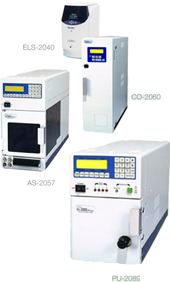
Experimental
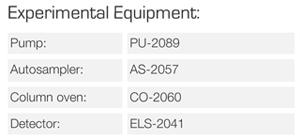
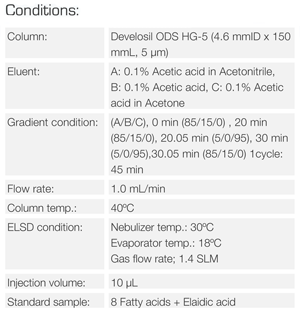
Results
Figure 1 shows a chromatogram of a standard mixture of 9 fatty acids including a trans fatty acid. Good separation within 20 minutes was achieved for both saturated and unsaturated fatty acids of C10 ~ C18, including the Elaidic acid of trans fatty acid.
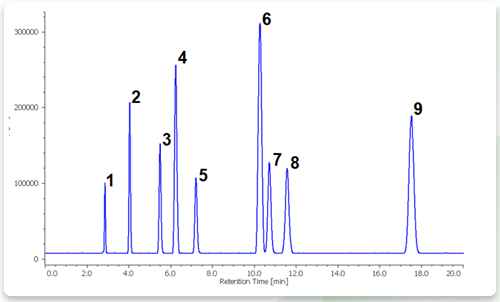
1: Capric acid (C10) 0.5 mg/mL, 2: Lauric acid (C12) 0.2 mg/mL, 3: Linolenic acid (C18:3) 0.1 mg/mL, 4: Myristic acid (C14) 0.1 mg/mL, 5: Linoleic acid (C18:2) 0.2 mg/mL, 6: Palmitic acid (C16) 0.1 mg/mL, 7: Oleic acid (C18:1) 0.2 mg/mL, 8: Elaidic acid 0.2 mg/mL, 9: Stearic acid (C18) 0.1 mg/mL
The chromatograms of rice bran oil and coconut oil are shown in figure 2 and 3, respectively.
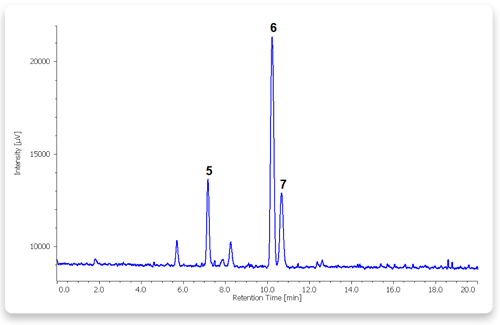
The peak names are the same as in figure 1. Sample preparation: 1.0 g rice bran oil was dissolved in 10 mL of acetone. The solution was then filtered through a 0.45 µm filter.

The peak names are the same as in figure 1. Sample preparation: 1.0 g coconut oil was dissolved in 10 mL of acetone. The solution was then filtered through a 0.45 µm filter.
A trans fatty acid, known as the unsaturated fatty acid with the double bond of trans type, is not contained in natural vegetable oil. It is generated during the manufacturing process of hydrogenated oil, such as margarine or shortening , when hydrogen is added. Since the possibility of causing the health impairment, such as heart disease, has been noticed during recent years, more countries are regulating the usage of products which contain trans fatty acids. The chromatograms of margarine itself and margarine added with Elaidic acid are shown in figure 4 and 5, respectively.
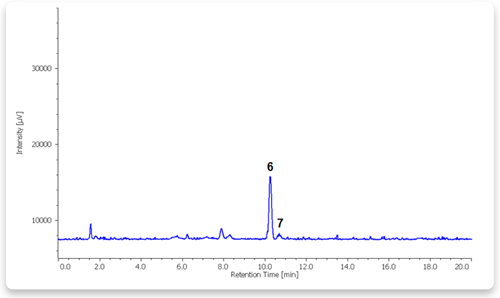
The peak names are the same as in figure 1. Sample preparation: 0.5 g margarine was dissolved in 10 mL of acetone. The solution was then filtered through a 0.45 µm filter.
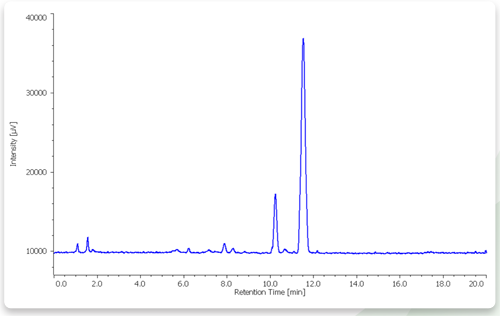
The peak names are the same as in figure 1. Sample preparation: Elaidic acid was added to sample of figure 4 to adjust the concentration of Elaidic acid to be 0.2 mg/mL.
Featured Products:

Analysis of Fatty Acids in Rice Bran Oil, Coconut Oil and Margarine by HPLC-ELSD
Introduction
Due to its poor UV absorbance, fatty acids have been commonly measured at a short UV wavelengths or using a refractive index detector – which can take a long time to establish a stable baseline. Pre-column derivatization is another well known approach in the analysis of fatty acids, but the procedure is complicated. ELSD is recognized as an effective method for lipid analysis providing high sensitivity and a stable baseline while also eliminating complex sample pre-preparation. As the sample becomes more volatile, with a shorter carbon chain, ELSD is normally considered inadequate and difficult to measure the fatty acid.
This report describes analysis using an ELSD capable of low temperature measurement, for saturated and unsaturated fatty acids with chain lengths C10 to C18.

Experimental


Results
Figure 1 shows a chromatogram of a standard mixture of 9 fatty acids including a trans fatty acid. Good separation within 20 minutes was achieved for both saturated and unsaturated fatty acids of C10 ~ C18, including the Elaidic acid of trans fatty acid.

1: Capric acid (C10) 0.5 mg/mL, 2: Lauric acid (C12) 0.2 mg/mL, 3: Linolenic acid (C18:3) 0.1 mg/mL, 4: Myristic acid (C14) 0.1 mg/mL, 5: Linoleic acid (C18:2) 0.2 mg/mL, 6: Palmitic acid (C16) 0.1 mg/mL, 7: Oleic acid (C18:1) 0.2 mg/mL, 8: Elaidic acid 0.2 mg/mL, 9: Stearic acid (C18) 0.1 mg/mL
The chromatograms of rice bran oil and coconut oil are shown in figure 2 and 3, respectively.

The peak names are the same as in figure 1. Sample preparation: 1.0 g rice bran oil was dissolved in 10 mL of acetone. The solution was then filtered through a 0.45 µm filter.

The peak names are the same as in figure 1. Sample preparation: 1.0 g coconut oil was dissolved in 10 mL of acetone. The solution was then filtered through a 0.45 µm filter.
A trans fatty acid, known as the unsaturated fatty acid with the double bond of trans type, is not contained in natural vegetable oil. It is generated during the manufacturing process of hydrogenated oil, such as margarine or shortening , when hydrogen is added. Since the possibility of causing the health impairment, such as heart disease, has been noticed during recent years, more countries are regulating the usage of products which contain trans fatty acids. The chromatograms of margarine itself and margarine added with Elaidic acid are shown in figure 4 and 5, respectively.

The peak names are the same as in figure 1. Sample preparation: 0.5 g margarine was dissolved in 10 mL of acetone. The solution was then filtered through a 0.45 µm filter.

The peak names are the same as in figure 1. Sample preparation: Elaidic acid was added to sample of figure 4 to adjust the concentration of Elaidic acid to be 0.2 mg/mL.

 Download This Application
Download This Application

